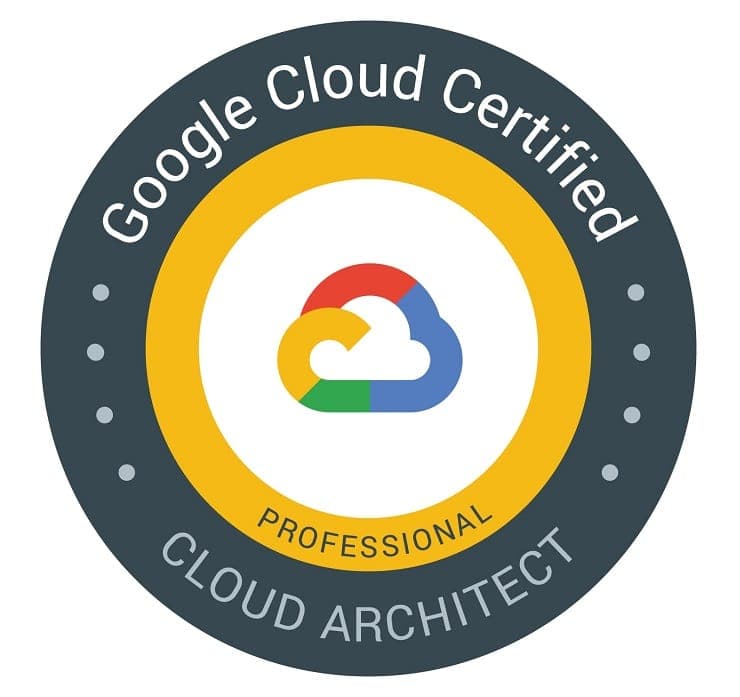Student Feedback
Associate Cloud Engineer Certification Video Training Course Outline
Google Cloud Associate Cloud Eng...
Google Cloud Regions and Zones
Google Compute Engine for Associ...
Google Compute - Optimization Co...
Gcloud for Associate Cloud Engineer
Getting Started with Instance Gr...
Load Balancing in Google Cloud P...
Managed Services in Google Cloud...
Getting Started with Google App ...
Getting Started with Google Kube...
Getting Started with Google Clou...
Google Cloud Run
Encryption in Google Cloud with ...
Block and File Storage in Google...
Object Storage in Google Cloud P...
Authentication and Authorization...
Choosing Database in Google Clou...
Exploring Database in Google Clo...
Asynchronous Communication in Go...
Private Networks in Google Cloud...
Operations in Google Cloud Platf...
Organizations and IAM - Organizi...
Pricing Calculator
Other Important Services
Getting Ready
Google Cloud Associate Cloud Engineer Certification - Getting Started
Associate Cloud Engineer Certification Video Training Course Info
Gain in-depth knowledge for passing your exam with Exam-Labs Associate Cloud Engineer certification video training course. The most trusted and reliable name for studying and passing with VCE files which include Google Associate Cloud Engineer practice test questions and answers, study guide and exam practice test questions. Unlike any other Associate Cloud Engineer video training course for your certification exam.
Google Compute Engine for Associate Cloud Engineer
10. Step 10 - Reducing Launch Time with a Custom Image
Welcome back. In previous steps, we saw how we can simplify the creation of virtual machines and setting up software on them using an instance template. However, there is one more problem with the approach that we took. Installing OS patches and software at the launch of VM instances increases boot-up time. So whenever we create an instance, if you're installing a lot of software or a lot of OS patches, then it takes a lot of time to launch that VM instance. How can we avoid that? One of the approaches that we can take is to create a custom image with OS patches and the software preinstalled. So we can create an instance, create a custom image out of it, and create further instances using that custom image. In Google Cloud, you can actually create a custom image in a number of ways. A little later in the course, we'll look at what is a persistent disc and what is a snapshot. Whenever we attach a hard disc with the instance, what we are attaching is a persistent disk, and a snapshot is nothing but a copy of a persistent disk. You can create a custom image from either a VMinstance, a persistent disk, a snapshot, another image, or, a little later, we'll also talk about cloud storage. Cloud storage is object storage, which is provided by Google Cloud. You can also store a file in cloud storage and create an image from it. We'll discuss this a little bit more when we talk about persistent discount snapshots. For now, what we do is actually create an image from an existing Compute Engine instance. Once you create a custom image, you can actually share it across projects. Google Cloud also provides the feature of deprecating old images. So whenever you create an image and, let's say, over a period of time, it has become an old image and you don't want anybody to use it, then you can mark it as deprecated. Along with marking it as deprecated, you can also say this is the new recommended image. So the recommendation is, whenever you are creating a new custom image and the old one is outdated, go ahead and mark the old one as deprecated. One of the advantages of actually creating a custom image is that all your corporate security standards are incorporated into the image. What you can do is actually create a VM instance that adheres to all your corporate security standards, and from that you can actually create an image. This process of doing this is called "hardening an image," creating an image that adds to all your security standards. Once you have a hardened image, you can use that to create secure VM instances. The next recommendation is to prefer using custom images for start-up scripts. Startup scripts include the boot-up time, so it's recommended to actually create a custom image. Let's now see how to create a custom image and how you can use that in an instance template. I have one VM instance, which is running right now. That's my instance template with startup script 1. If I minimise this and actually expand storage, this is where you can see disks, so nothing but the hard discs that are associated with your virtual machine. Whenever you create a virtual machine, the operating system of the virtual machine runs on a hard disc that is attached to that specific virtual machine, and that's what you are seeing here. You can see this specific disk, which is attached to our virtual machine. You can see that it also has the same name as my instance template with startup script one, and you can see that by default it has a size of about ten GB. Now we would want to create an image. We'd want to create a copy of this specific disk. How can we create an image from the specific disk? The way you can do that is by going to Actions and clicking Create Image. So we'd go ahead and say "Create image." You can see that the source of this specific image is a disk. The name of the disc is present here, and if you scroll down you can also choose the location. Do you want this image to be stored multiregionally or regionally? If you expect this image to be used in other regions, then you can go with multi regional.If you are expecting this image to be used only in a specific region, then you can go with regional. What I would do is I wouldleave it at the default multi regional. I'll take the default for the rest of the things, including encryption, and I would go ahead and say Create. When I press the Create button, an error message appears. The reason for the error is because the disc is now attached to a running instance. The recommendation is that you should never create an image from a disc that is connected to a running instance. You should always stop the instance and then create an image from that specific disk. So what we do is actually go in and go to the virtual machine instances, open it in a new tab, and you can go in here and select this, and I would want to actually stop this. So we are stopping the virtual machine instance. Let's wait for it to be stopped. You can check this checkbox and takean image without stopping the instance. However, that is not really recommended, and that's the reason why we have started to stop the instance, and you can see that the instance is not stopped, and I would go ahead and say, "Take a copy," or "Create it," so you're not discovering the fact that it's stopped. So let's do a cancel, let's go back to disks, and let's not try to create the image again. So let's say we create an image. I'll call this my custom image I'll choose the same options that we chose earlier and create now" because the instances have stopped. It will go ahead and create that specific image. The creation of the image would take a little while, so it's going on the list of images. You can see all the public images that are present here. The one that we have created just now is a private image. If you wait a few minutes and do a refresh, then you'll see our specific image come up here. You can see that my custom image is present here, and within a couple of minutes, you'd see that its status is "ready to use." Now I can go ahead and use this to create a VM instance, so what I would need to do is go ahead and say "Create instance," or the other option is that I can actually create an instance template based on this specific image as well. So I can go into virtual machines, and let's go to instance templates, and what we would want to do is actually use this instance template and make a copy. So I'll make a copy of the existing instance template that copies everything from the previous instance template. I've renamed this to my instance template with image, or with Customimage, and I'm going to go over here. I'd take the same machine family as earlier and the boot disk. I'd like to change this so that I can use my custom image instead of Debian. So I would go in here and click Custom Images and select the image. So if you wait for a little while, my custom image should appear in here, and you can select it. Once you select that, you can go into management, security, networking, and other stuff. And over here in the startup script, you don't really need to do the install. All that you need to do is create the HTML file because you'd want to put host-specific information in there, and once you create the HTML file, you'd also want to start up the server. So you want to launch Apache. The way we can do that is by just saying "Server Apache to start." So we are populating the HTML file, and then we are starting up the web server. We don't really need to install Apache anymore because it's already part of the image. So this would create an instance template. This is using the custom image that we created, and using this instance template, you can actually launch as many instances as you want, and these instances would be created with the custom image that we created. I can go ahead and create instances using this particular virtual machine. Create a virtual machine I'll take all the defaults that are suggested and say "Create." And while the new instances are being created, what I would do is delete the old instance, which was created with this startup script. So I'll go ahead and delete that. I don't really need that anymore. My instance template with custom images is now ready. Give it a couple of minutes, and then go ahead and click external IP. You should then see my instance template with custom image 1012 805. And you can see that this is the internal IP of this specific one. So you can see that over the last few steps, we have understood a lot about virtual machines. We were playing with the life cycle of the virtual machines, deciding when to stop, start, or delete them. We also played with instance templates, and we also played with email.
11. Step 11 - Troubleshooting Launch of Apache on GCP Virtual Machine
Welcome back. Let's take it one step at a time and try to understand how to debug problems if you're having trouble installing the Apache Web server or running this specific URL. Now let's say you went through all the steps but were not able to see this URL launch up. You have used the external IP, which is present for the instance, and let's say you are running it and you are still having a problem. What are the things that you would want to check? Number one, make sure that you are using the external IP of the running instance. If I refresh the VM page, this is where I can see the external IP. Make sure that you click that and open it in a new window, so that's number one. So make sure that you're using the right URL. If you are sure that you are using the right URL, then what you can do is go and SSH into it. Make sure that you are able to SSH into it. If you are able to SSH into it, then make sure that your Apache Web Server is properly installed. I can perform an LS and examine wirewashtml. So, lswarml, and what do I see? I see an index HTML file, which is present here. Now I would want to see what content is present in this specific file. So I'll say "catwarwindex HTML." What would it show? It shows the content of this specific file. You can see that the content of this specific file is what I am seeing on the web browser. So make sure that this file is present and has the right content that you want to see. Once you make sure that the file is there and the content is fine as well, what you can also do is make sure that the Apache service is started up properly. So you can type in service Apache two space start. Before we are able to do a service with Apache, I would actually need to do a pseudo sudo sue andthen I would do a service Apache to start and thiswould ensure that the Apache server is also started up. And after this, you can actually go and check if your URL is working. If your URL is still not working, there is one more thing that you can check, which is to click this VM instance. So open the VM instance app, and if you scroll further down, you should see firewalls, and in the firewalls, you should see LFHTP traffic checked. If you do not see this checked, you can edit this and check that. So if you say edit, you can go in here, check this check box, and make sure that you save it. Once you save the VM instance, you can go and click on the external IP of it, and you should see the page come up. In this video, we looked at how you can debug problems with installing the Apache web server on a VM instance I'm sure you're having an interesting day, and I'll see you in the next step.
12. Step 12 - Playing with Google Cloud Platform (Web) Console
Back. Let's take a step back and look at the entire interface, which is offered by the Google Cloud Platform web console. This is also called just the console. Whenever people say "console," then they are referring to this specific thing. And over here, the most important thing is the pencil, which is present in this area. You can go in here and access the different services that are present in here.The other way you can access the services is the way we have been doing it until now. So let's say I would want to access Kubernetes' engine. I can type Kubernetes in here, or I can go to the pencil and navigate to Kubernetes. It would be under "Compute," and then I can go in and access that specific service. The interesting thing about using the pencil isthat whenever you want to actually make markanything as favorite, you can actually pin it. Maybe I'll be playing with Compute Engine a lot, then I can go ahead and pin this. So what would happen is that ComputeEngine would appear in here. So when I click my navigation menu, I can see Compute Engine right at the top. So if you're playing with any service a lot, then you can make use of this feature, and you can directly access your VM instances. Now let's see what's under Home. Under home. You can see my dashboard. Dashboard is the screen which we sawwhen we first came to Google Cloud. It contains the project information. It contains different APIs that we are making use of. You can see that we are making a lot of API calls. Whenever we create resources, a lot of APIs are called, and those are the resources that we are seeing here. Over here, you can also see the current status of the Google Cloud Platform. You can see that all these services are normal right now. You can also see the billing information, and if you scroll down, you'll also see a lot of information around monitoring and error reporting. Another thing you'd see in here is activity. If you go to "Activity," you will see a lot of information about what you have been doing until now. So over here, you can see that I have been doing a lot of activities, such as creating and deleting VMs and playing around with them. So you can see that. And if you want, you can go ahead and filter among the activities. So you can go to the activity type and select what kind of activities you are interested in. configuration, data access, development, or monitoring. You can also choose which type of resource you want to focus on. You can see that almost 75 different types of resources are selected here. By default. You can choose whichever one you want to look at. The last tab that is present here is Recommendations. Google Cloud would automatically analyse your cloud usage and, if they have any recommendations, they would show them here. As of now, as you can see, there are no recommendations for me other than that. If you click the pencil and go to the left-hand side, you can see all the services that are present here. As a result, you can see Compute Services. You can see Compute services on the lefthand side, a lot of them in here. You can also see different You can see storage services, databaseservices, you can see the networkingservices which are present in here. And there are also other services to support your operations. And there are a few tools, and you'll also see services to help you with big data and artificial intelligence. as you can see here. This is the project that we are working on. My first project If you want, you can actually create a new project and create resources under that specific project as well. Right now, let's keep using my first project, which is the default project that was created for us. Other than that, in the top menu you can also see your free trial status. If you click this, you can see how much of your free trial credit is remaining and how many days are remaining in your free trial. You can get help by clicking this question mark here, and if there are any notifications, you can see them in this section. There are notifications created whenever you create, delete, or update an instance. There will be notifications created for that. And you can click the three dots here to look at a few more settings. If you go in here and go over to Project Settings, you'll be able to see the settings for our current project. The idea behind this step was to quickly navigate around and play around with the cloud console so that you are familiar with it when you keep using it. During this specific course What I'll do now is go ahead and click Dismiss over here, and I'll see you in the next steps.
Google Compute - Optimization Costs and Perfomance in Google Cloud Platform
1. Step 01 - Understanding Sustained Use Discounts in GCP - Google Cloud Platform
Welcome back. Until now, we have been playing with virtual machines. Starting this step, let's look at a few important things that you need to understand about keeping your costs low. Whenever you are making use of the cloud, you want to keep your costs as low as possible. What are the things that you can do to keep the cost of your virtual machines low? The first thing that we will be talking about is sustained-use discounts. What is the sustained use discount? It's an automatic discount that is applied for running VM instances for a significant portion of the billing month. For example, if you are using N one or N two machine types for more than 25% of the time period of the month, then you get about a 20 to 30% discount on every incremental minute. So beyond 25%, whatever time period you are running for, you'd get a discount on it, and the discount increases with the usage. If you are using the VM for 80% of the month, the amount of discount you would get would be higher than the amount you would get if you were only running it for 40%. And the great thing about this change in use discounts is that you don't really need to do anything. There is nothing you need to do specifically for this. When you are creating or running your virtual machines, this is automatically applied by the platform itself. However, there are a few important restrictions that you need to remember a little later in the course. We will also be talking about Google Kubernetes Engine, which is a managed Kubernetes service provided by Google Cloud Platform. When you're creating instances using the Google Compute Engine, that's basically what we are using in the course. Until now, or whenever you create instances using the Google Kubernetes engine, the sustained use discounts have been applied automatically. Remember that this does not apply to certain machine types. For example, if e and a are two, the sustained use discounts do not apply to them. And also remember that if you're using AppEngine, Flexible, or Data Flow to create the VMs, sustained use discounts do not apply. We'll talk about App Engine and data flow as we go further in this course. The important thing to remember about sustained discounts is the fact that these are automatically applied when you use instances that are created by Google Kubernetes Engine and Compute Engine for a significant part of a specific month. Also, remember that there are a few restrictions. I'm sure you're having an interesting time, and I'll see you on the next step.
2. Step 02 - Understanding Committed Use Discounts in GCP - Google Cloud Platform
Welcome back. In this step, let's look at another type of discount that is applied to your virtual machines. How about this type of discount need acommitment from you and that's the reason whythese are called Committed Use Discounts. Using committed use discounts is recommended for workloads with predictable resource needs. You can say I would need a virtual machine of this type for one year or three years. And depending on the machine type and the GPUs you are asking for, you can get up to a 70% discount. The discount that you would get with committed use discounts is higher than the discount that you would get with sustained use discounts. So if you're sure that you need a specific virtual machine for one year or three years, then it makes sense to go ahead and register for a committed use discount because this gives you a larger discount. And again, depending on a sustained use discount, the committed use discount is applicable for instances that are created by Google, Kubernetes Engine, and Compute Engine. And the same restriction that we talked about when we talked about sustained use discounts applies for committed use discounts as well. This does not apply for VMs created by the App Engine's flexible data flow. Now, how can you ask for a Committed Use discount? Let's go back to our virtual machines, and in the menu for the virtual machines, the last option you would see is Committed Use Discounts. This is where you can actually go in and ask for a committed use discount. Here is where you can actually go in and purchase a commitment. So I can go ahead and say "Purchase a commitment," or I can say "I want to purchase a specific commitment." As you can see here, you can actually purchase a hardware or software commitment. What we are interested in is a virtual machine commitment, which is a hardware commitment. So you can give it a name, you can choose which region you'd want to have the commitment in, and you can choose the specific family you'd want to commit to. Then you can specify the length of time you want to commit to. You can also specify a little bit about the configuration of the machine you want. Do you want a course? Do you want a memory? Do you want GPUs? Do you want local SSDs? And then you can go ahead and click "Purchase." I'm not going to click "Purchase" in here because I don't really want to commit to it. What I would do is go ahead and say "cancel." Once you register a commitment, if you create any new instances of that type, the discount is automatically applied. In the next step, we talk about committed use discounts. These are recommended for workloads with predictable resource needs ahead of time that I would want to run over a long period of time. In those kinds of situations, you can get the best discounts by going for a committed use discount. I'll see you at the next step.
Pay a fraction of the cost to study with Exam-Labs Associate Cloud Engineer certification video training course. Passing the certification exams have never been easier. With the complete self-paced exam prep solution including Associate Cloud Engineer certification video training course, practice test questions and answers, exam practice test questions and study guide, you have nothing to worry about for your next certification exam.













